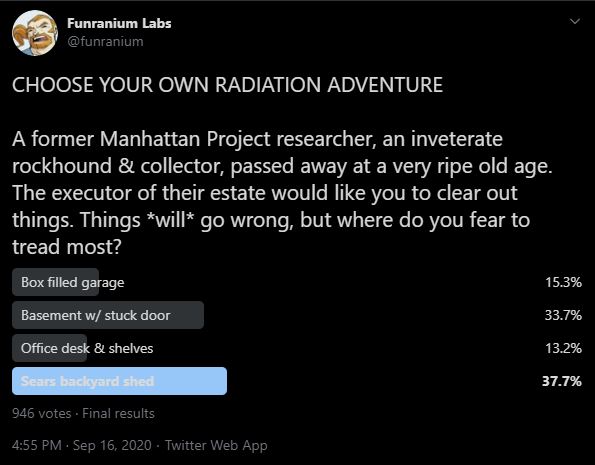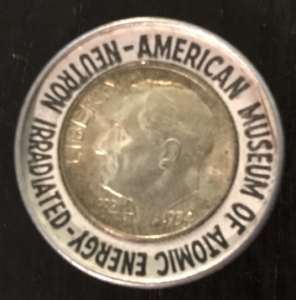It’s clear that folks have some experience clearing out the homes & offices of deceased friends and relatives who were eccentric. From the previous Radioactive Seagull Adventure, perhaps they were the Local Color.
Inherit enough interesting things, you might get known as the Local Color too.
It’s clear that many made the inference “Manhattan Project researcher” + “rockhound” + “collector” = ALL THE RADIOACTIVE MINERALS. Having cleared out my fair share of places, this isn’t a bad inference. If you aren’t using Fiestaware as a check source, U/Th minerals work well too.
But for this scenario, I asked where do you fear to tread the most. This is cruel trickery on my part as it prompts you with “fear” and that prompting causes you to try to think like the deceased through a lens of fear of the objects in their home. A big part of situations like this is sleuthing. The radioactive, toxic, etc. characteristics of your substances are intrinsic. How they got to where they are now and, how bad that might be, is a function of human behavior which is what you’ve got to figure out. The prompt to fear kept most of you from starting at the real motivation point of a collector: love & obsession. That completely shifts where you find things.
The hard part then is trying to figure out “What were they collecting? What were they trying to complete a set(s) of?” As an example, I am a coin collector but this doesn’t mean I collect ALL coins. I collect mostly American coins. But then you see coins from the Philippines. Wait, how do these and the Kingdom of Hawaii coins fit into an American coin collection? This is because in the larger collection, there is a subset of “This Is ALSO American Money”. And then you see this coin in a different smaller binder. Because I also have the Atomic Coin Collection.
If you didn’t already know the deceased, as you start looking around the place you start forming a picture of the person. You start figuring out what they cared about and the hierarchy of love and pride in their possessions, which is normally expressed by proximity. To a first approximation, the garage, basement and shed contains the things that are either too large, too dangerous, duplicates in the collection, or are outliers that just don’t quite fit a theme in the collection. The desk & shelves will have the most treasured mementos, the best examples of type, the most exotic things, and the most difficult to complete collections. In short, you will find the things they wanted to show off. The prettiest minerals specimens will be here. @mikamckinnon, DO NOT LICK! But as you look around in here you’re going to learn what the collections, note the plural, are. NOTE: just look, do not touch yet.
Personally, I have the utmost terror of offices because a live grenade has been a treasured item more than once. But that’s me. And, JUST BECAUSE, before you start opening drawers in filing cabinets and desks be sure you have gloves, I want you too look very closely for wires connected to things and for something that looks like can on the corner. Thermite document destruction happens. :(
Some of you already expressed an appropriate terror of accidentally discovering classified materials. Hopefully, you don’t find anything and there’s no document safe. But if you do, DON’T READ THEM ANY FURTHER, stick it in a bag and keep custody of it until you can turn it over. Promptly. Annoyingly, this is a security violation to even have in your possession but you tend to get the benefit of the doubt for turning them over as soon as possible. It probably was for the deceased too but, well, they’re dead and no longer subject to disciplinary action. Also, don’t be surprised to find various loaded firearms in the office. It happens.
We move on to all the boxes in garage. This represents the second strata of their collections and their most recent/unsorted acquisitions. If there’s a workbench in here, that will have the newest and most interesting items. This will also be where you find the first big item. I can’t begin to tell you what that big item is going to be, but the collection will be an indicator. Maybe it’s a boulder. Maybe it’s restored Sherman tank. Maybe it’s the largest damn vacuum tube you’ve ever seen that is, oddly, radioactive too. The boxes on the shelves here in the garage are going to constitute larger mineral samples and, knowing collectors, they’ve been sorted. Hopefully the heaviest things are on the bottom shelf, but safety isn’t usually the priority of collectors. Most of them won’t be radioactive. The nature of the sorting is going to be hard to tell without some detailed mineralogy knowledge. One hopes it’s been done by mineral groups, like “here’s a big box o’ spinels”, but it’s just as likely that you’ve got “various ores”. Meter survey to separate the rad and try to avoid the arsenic & mercury.
Moving on to the stuck door to the basement, with a modicum of brute force greater than a nonagenarian can exert or a crowbar, you are now entering a space that the deceased hasn’t touched in years. This is the Realm of Abandoned Projects. Before the door stuck and the stairs down to the basement became too hard to negotiate, the basement is where old researchers go to putter. If you’re lucky, the puttering of choice is a 1500sqft model train layout. If you’re unlucky, that layout is of the Nevada Test Site. One of those things that may let you know if you’re in for Very Interesting Projects is the electrical box. If you see they have more electrical service that you might usually expect you may, for example, discover a synchrotron or fusor cobbled together downstairs. A collection of instrumentation racks still bearing AEC property tags on them from when they were discarded, grabbed from the dump and set back up to make a home counting lab. You know, to see how good their ores are. With a dissolver chemistry set to do that…
It may, or course, just be even more falling apart boxes of stuff and ALL THE RADON. Hopefully the fan blowing all that clear is still working, but no ones checked in a while and it doesn’t take long for a basement filled with ore to evolve a fair bit of radon and daughters. There are, of course, even more workbenches and the remains of decades of tinkering down here. This is also where you’re likely to find the largest chemical storage, though unlikely with proper storage. If you’re in earthquake country, lucky you got there before the big one.
And so you step out into the sun again and approach the shed purchased from Sears and put up decades earlier. The memory of David Hahn, the Radioactive Boy Scout, popped into people’s minds. Bless his heart, Hahn was an amateur and fairly incompetent. To do anything scary out in the shed with a head full of Manhattan Project, you’re gonna need to run utilities. You’ll notice if that’s happened and back off appropriately. But from the collector point of view, what you’re going to find out here are the things they cared about least or that are the most dangerous. And that doesn’t mean most dangerous parts of the collection, like the 108mm DU round with live primer which is *obviously* at the side of their desk, but more like the boxes of dynamite, blasting caps and jugs upon jugs upon jugs of gunpowder. The things you want well away from the house because it might cause you to not have a house anymore. For the collector, you may find rusting drums filled with their least appealing specimens of crumbling carnotite. Or possibly jerrycans with waste from basement chemistry that never made it to household waste (or never could). But radiologically speaking, kinda boring.
In the events that inspire this particular scenario, I was asked to clean out a deceased researcher’s office because, and I quote, “You have the most experience doing this other than me and I don’t have to do it because I’m your boss.”
A non-exhaustive list of the things I found in this office:
- A signed, live grenade
- Oxidized beryllium metal special form parts
- Various nuclear fuel pellets
- Xmas lights hung & wrapped around det cord
- Machined explosive as a paperweight
- A can of Agent Orange
- AND SO MUCH MORE!!!
Also, labeled chunks of fused glass from various nuclear tests. These were treasures they’d collected over a long career in national service, military and otherwise. As far as I know, most of the things in that office vanished into other people’s offices to enhance their collections. The explosives were disposed of…spectacularly.
I can only hope that when I pass my collections similarly leave someone wondering exactly how I accumulated all this and what stories does it all tell. Ideally, you should tell people what your collections mean to you, to educate others, before you die.
~fin~
P.S. – If you’ve ever wondered where the Coin Rants on the blog come from, that’s me using my coin collection for its real overarching purpose: to tell stories with. Here’s an example. I can tell a slice of history with pretty much every one of my coins. ;)

